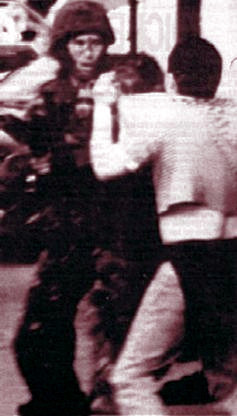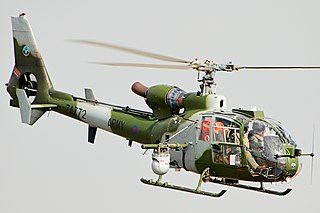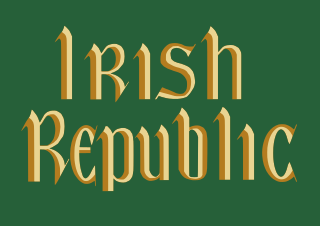| Operation Helvetic | ||||||
|---|---|---|---|---|---|---|
| ||||||
| Belligerents | ||||||
| | ||||||
Operation Helvetic is the operational name for the British Armed Forces' residual [1] operation in Northern Ireland from July 2007 to the present day.
| Operation Helvetic | ||||||
|---|---|---|---|---|---|---|
| ||||||
| Belligerents | ||||||
| | ||||||
Operation Helvetic is the operational name for the British Armed Forces' residual [1] operation in Northern Ireland from July 2007 to the present day.
It was the successor operation to Operation Banner after the end of The Troubles. [2] It consists primarily of support from Ammunition technical officers for the Police Service of Northern Ireland against an ongoing threat of bomb attacks from republican and loyalist dissidents. [3] The operation is also intended to provide military support to the PSNI in the event of serious public disorder or an environmental crisis. [4]
At the start of the operation the total British army strength was approximately 5,000 soldiers in ten locations. [5] By 2018 this had reduced to around 1,300 troops [6] only for training purposes. [7] Thus far two British soldiers have been killed by republican paramilitaries during the operation, both killed in the 2009 Massereene Barracks shooting.
In 2016 ATOs serving as part of Operation Helvetic dealt with terrorist bomb alerts roughly once a week. Of these 49% were classified as "serious threats". The lack of a General Service Medal for ATOs serving as part of Operation Helvetic was the subject of controversy in 2017 following the rejection by the cabinet office of a request for the award of the GSM to ATOs from Andrew Rowe, Northern Ireland's most senior army officer. [1]
In 2018 the operation was the subject of a freedom of information request brought by the Committee on the Administration of Justice, which was seeking the disclosure of the terms of reference for Operation Helvetic. [8] The request was opposed by the UK ministry of defence on grounds of operational secrecy. Though the Information Commissioner's Office found against the MoD, the MoD plans to appeal the decision.
The cost of Operation Helvetic was approximately £1 billion a year in 2019. By 2019 increasing numbers of specialist troops were being deployed as part of the operation due to an uptick in the activity of Republican dissidents. [9]
The Real Irish Republican Army, or Real IRA (RIRA), was a dissident Irish republican paramilitary group that aimed to bring about a United Ireland. It formed in 1997 following a split in the Provisional IRA by dissident members, who rejected the IRA's ceasefire that year. Like the Provisional IRA before it, the Real IRA saw itself as the only rightful successor to the original Irish Republican Army and styled itself as simply "the Irish Republican Army" in English or Óglaigh na hÉireann in Irish. It was an illegal organisation in the Republic of Ireland and designated as a proscribed terrorist organisation in the United Kingdom and the United States.

The Troubles were an ethno-nationalist conflict in Northern Ireland that lasted about 30 years from the late 1960s to 1998. Also known internationally as the Northern Ireland conflict, it is sometimes described as an "irregular war" or "low-level war". The conflict began in the late 1960s and is usually deemed to have ended with the Good Friday Agreement of 1998. Although the Troubles mostly took place in Northern Ireland, at times violence spilled over into parts of the Republic of Ireland, England and mainland Europe.

Joint Helicopter Command (JHC) is a tri-service organisation uniting battlefield military helicopters of the British Armed Forces for command and coordination purposes.

The South Armagh Brigade of the Provisional Irish Republican Army (IRA) operated during the Troubles in south County Armagh. It was organised into two battalions, one around Jonesborough and another around Crossmaglen. By the 1990s, the South Armagh Brigade was thought to consist of about 40 members, roughly half of them living south of the border. It has allegedly been commanded since the 1970s by Thomas 'Slab' Murphy who is also alleged to be a member of the IRA's Army Council. Compared to other brigades, the South Armagh IRA was seen as an 'independent republic' within the republican movement, retaining a battalion organizational structure and not adopting the cell structure the rest of the IRA was forced to adopt after repeated intelligence failures.
The Troubles were a period of conflict in Northern Ireland involving republican and loyalist paramilitaries, the British security forces, and civil rights groups. They are usually dated from the late 1960s through to the Good Friday Agreement of 1998. However, sporadic violence continued after this point. Those that continued violence past this point are referred to as "dissident republicans and loyalists". The Troubles, internationally known as the Northern Ireland conflict, claimed roughly 3500 lives.

Operation Banner was the operational name for the British Armed Forces' operation in Northern Ireland from 1969 to 2007, as part of the Troubles. It was the longest continuous deployment in British military history. The British Army was initially deployed, at the request of the unionist government of Northern Ireland, in response to the August 1969 riots. Its role was to support the Royal Ulster Constabulary (RUC) and to assert the authority of the British government in Northern Ireland. This involved counter-insurgency and supporting the police in carrying out internal security duties such as guarding key points, mounting checkpoints and patrols, carrying out raids and searches, riot control and bomb disposal. More than 300,000 soldiers served in Operation Banner. At the peak of the operation in the 1970s, about 21,000 British troops were deployed, most of them from Great Britain. As part of the operation, a new locally-recruited regiment was also formed: the Ulster Defence Regiment (UDR).
The Ballygawley bus bombing was a roadside bomb attack by the Provisional Irish Republican Army (IRA) on a bus carrying British soldiers in Northern Ireland. It occurred in the early hours of 20 August 1988 in the townland of Curr near Ballygawley, County Tyrone. The attack killed eight soldiers and wounded another 28. In the wake of the bombing, the British Army began ferrying its troops in and out of County Tyrone by helicopter.
The 2010Newry car bombing occurred on the night of 22 February 2010. It exploded outside a courthouse in Newry, County Down, Northern Ireland, damaging the building and others in the area. There were no fatalities or injuries.

The 1992 Coalisland riots were a series of clashes on 12 and 17 May 1992 between local Irish nationalist civilians and British Army soldiers in the town of Coalisland, County Tyrone, Northern Ireland. The Third Battalion 1992 tour's codename was "Operation Gypsy".

Óglaigh na hÉireann was the title taken by a small dissident Irish republican paramilitary group that took part in the dissident Irish Republican campaign. The organisation started carrying out attacks around 2009 and was formed after a split within the Real IRA, led by Seamus McGrane.

The dissident Irish republican campaign began at the end of the Troubles, a 30-year political conflict in Northern Ireland. Since the Provisional Irish Republican Army called a ceasefire and ended its campaign in 1997, breakaway groups opposed to the ceasefire and to the peace agreements have continued a low-level armed campaign against the security forces in Northern Ireland. The main paramilitaries involved are the Real IRA, Continuity IRA and formerly Óglaigh na hÉireann. They have targeted the Police Service of Northern Ireland (PSNI) and the British Army in gun and bomb attacks as well as with mortars and rockets. They have also carried out bombings that are meant to cause disruption. However, their campaign has not been as intensive as the Provisional IRA's, and political support for groups such as the Real IRA is "tending towards zero".

On 17 February 1978, a British Army Gazelle helicopter, serial number XX404, went down near Jonesborough, County Armagh, Northern Ireland, after being fired at by a Provisional IRA unit from the South Armagh Brigade. The IRA unit was involved at the time in a gun battle with a Green Jackets observation post deployed in the area, and the helicopter was sent in to support the ground troops. The helicopter crashed after the pilot lost control of the aircraft whilst evading ground fire.

The Battle of Newry Road was a running gun battle between British Army helicopters and Provisional Irish Republican Army (IRA) armed trucks, fought along the lanes east of Crossmaglen, County Armagh, on 23 September 1993. The engagement began when an IRA motorized team from the South Armagh Brigade attempted to ambush three helicopters lifting off from the British Army base at Crossmaglen, one of them carrying the 3rd Infantry Brigade Commander.
5 Regiment Army Air Corps is a regiment of the British Army and is part of the Joint Helicopter Command (JHC). The regiment is based in Northern Ireland at JHC Flying Station Aldergrove.

On 27 August 1975 a Provisional Irish Republican Army bomb exploded without warning at the Caterham Arms public house in Caterham, Surrey, England. No-one was killed but 33 people were injured, some severely, including three off-duty soldiers who lost limbs.
The Provisional IRA (IRA) planted a bomb underneath a minibus at an army recruiting centre in Wembley, northwest London on 16 May 1990, killing a soldier and injuring four others. The dead victim was the van's driver, 34-year-old Sergeant Charles Chapman from the Queen's Regiment, a father of two. The injured included his colleague, who got shrapnel wounds to his legs and right shoulder, and a burned face. The bomb was believed to have been 2 lb (910 g) of Semtex and shattered nearby windows when it exploded around 5:15 pm. The van was an unmarked white Leyland Sherpa parked in an alleyway behind the office, which was checked by the two soldiers beforehand but the bomb was cleverly hidden, and detonated as Chapman turned on the ignition. The bomb could have caused more casualties had it exploded later when the van entered the busy street.

Throughout the protracted conflict in Northern Ireland (1960s-1998), the Provisional IRA developed a series of improvised mortars to attack British Army and Royal Ulster Constabulary (RUC) security bases. The organisation also purchased both light and heavy machine guns in order to hamper the British Army supply of border bases by helicopter. The IRA fitted vehicles, specially vans and trucks, with both type of weapons. Vans, trucks and tractors were modified to transport concealed improvised mortars to a launch area near the intended target and fire them, while light and heavy trucks were employed as firing platforms mounting machine guns, particularly M60s and DShKs. Improvised armoured vehicles and heavy equipment were also used to penetrate the perimeter of fortified security bases. The IRA vehicles were often disguised as belonging to civilian companies or even government agencies.

On 12 December 1993, a unit of the Provisional Irish Republican Army's (IRA) East Tyrone Brigade ambushed a two-men unmarked mobile patrol of the RUC in Fivemiletown, County Tyrone. Two constables were shot and killed instantly. A military helicopter was also fired at by a second IRA unit in the aftermath of the incident, during a follow-up operation launched in the surroundings of the town by both the British Army and the RUC. A number of suspects were questioned, but the perpetrators made good their escape. The action occurred just three days before the Downing Street Declaration.

The New Irish Republican Army, or New IRA, is an Irish republican paramilitary group. It is a continuation of the so-called Real Irish Republican Army, which began to be called the 'New IRA' in July 2012 when Republican Action Against Drugs (RAAD) and other small republican militant groups merged with it. The group calls itself simply "the Irish Republican Army". The New IRA has launched many attacks against the Police Service of Northern Ireland (PSNI) and the British Army. It is the largest and most active of the "dissident republican" paramilitary groups waging a campaign against the British security forces in Northern Ireland.